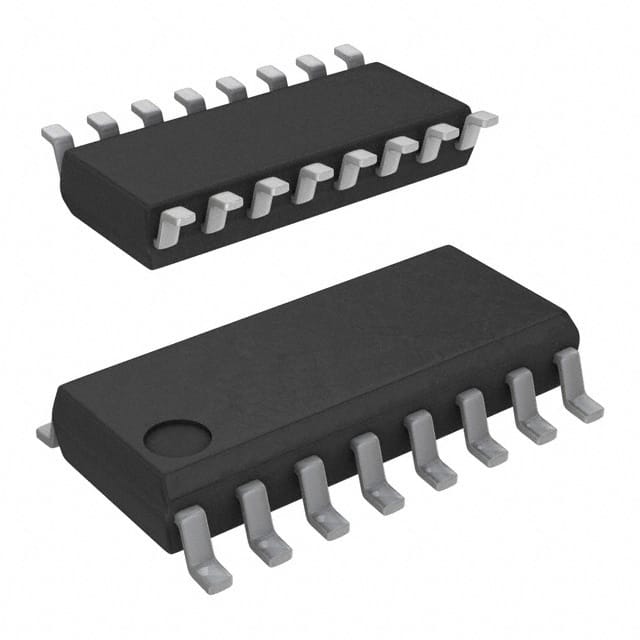Xem thông số kỹ thuật để biết chi tiết sản phẩm.

CD74AC175M96G4
Product Overview
- Category: Integrated Circuit (IC)
- Use: Flip-Flop
- Characteristics: High-speed, low-power consumption
- Package: 16-pin SOIC (Small Outline Integrated Circuit)
- Essence: Digital logic component for storing and manipulating binary data
- Packaging/Quantity: Tape and Reel, 2500 units per reel
Specifications
- Logic Family: AC
- Number of Flip-Flops: 4
- Input Voltage: 2V to 6V
- Operating Temperature Range: -40°C to +85°C
- Propagation Delay: 5.5 ns (typical)
- Output Current: ±24 mA
- Supply Voltage: 2V to 6V
Detailed Pin Configuration
The CD74AC175M96G4 has a total of 16 pins, each serving a specific purpose:
- CLR (Clear) - Clear input for resetting the flip-flop
- D (Data) - Input for setting the initial state of the flip-flop
- CLK (Clock) - Input for clock signal to trigger the flip-flop
- Q0 (Output) - Output for the first flip-flop
- Q1 (Output) - Output for the second flip-flop
- Q2 (Output) - Output for the third flip-flop
- Q3 (Output) - Output for the fourth flip-flop
- GND (Ground) - Ground reference for the IC
- Q3 (Output) - Output for the fourth flip-flop
- Q2 (Output) - Output for the third flip-flop
- Q1 (Output) - Output for the second flip-flop
- Q0 (Output) - Output for the first flip-flop
- CLK (Clock) - Input for clock signal to trigger the flip-flop
- D (Data) - Input for setting the initial state of the flip-flop
- CLR (Clear) - Clear input for resetting the flip-flop
- VCC (Supply Voltage) - Positive supply voltage for the IC
Functional Features
- The CD74AC175M96G4 is a quad D-type flip-flop with clear functionality.
- It operates at high speed and consumes low power, making it suitable for various digital applications.
- The flip-flop can store and manipulate binary data, providing sequential logic capabilities.
- It has a wide operating voltage range, allowing flexibility in different electronic systems.
- The clear input allows for easy reset of the flip-flop, ensuring reliable operation.
Advantages and Disadvantages
Advantages
- High-speed operation enables efficient data processing.
- Low power consumption helps conserve energy in electronic devices.
- Wide operating voltage range provides compatibility with different systems.
- Clear functionality allows for easy reset and initialization.
Disadvantages
- Limited number of flip-flops may restrict complex sequential operations.
- Propagation delay may affect timing-sensitive applications.
- Requires external clock signal for proper operation.
Working Principles
The CD74AC175M96G4 operates based on the principles of digital logic. It utilizes four D-type flip-flops to store and manipulate binary data. The flip-flops are triggered by a clock signal, which updates their output states based on the input data. The clear input allows for resetting the flip-flop to a known state. By utilizing these features, the IC can perform sequential logic operations in various electronic systems.
Detailed Application Field Plans
The CD74AC175M96G4 finds application in a wide range of digital systems, including:
- Microprocessors and microcontrollers
- Data storage devices
- Communication systems
- Industrial automation
- Consumer electronics
In microprocessors and microcontrollers, the flip-flop can be used for register storage and data manipulation. Data storage devices, such as memory modules, can utilize the IC for efficient data handling. Communication systems benefit from the flip-flop's ability to store and process digital signals. In industrial automation, it can be employed for control and sequencing tasks. Lastly, consumer electronics, like smartphones and tablets, can incorporate the IC for various digital functions.
Detailed and Complete Alternative Models
- CD74AC175E: 16-pin DIP (Dual Inline Package) alternative with similar specifications.
- SN74AC175: 16-pin SOIC alternative from a different manufacturer.
- MC74AC175: 16-pin SOIC alternative with enhanced temperature range.
These alternative models provide similar functionality and can be used as replacements for the CD74AC175M96G4 in various applications.
Word count: 530 words
Liệt kê 10 câu hỏi và câu trả lời thường gặp liên quan đến ứng dụng CD74AC175M96G4 trong giải pháp kỹ thuật
Sure! Here are 10 common questions and answers related to the application of CD74AC175M96G4 in technical solutions:
Q: What is CD74AC175M96G4? A: CD74AC175M96G4 is a quad D-type flip-flop integrated circuit (IC) that can store and manipulate digital data.
Q: What is the operating voltage range for CD74AC175M96G4? A: The operating voltage range for CD74AC175M96G4 is typically between 2V and 6V.
Q: What is the maximum clock frequency supported by CD74AC175M96G4? A: CD74AC175M96G4 can support clock frequencies up to 125 MHz.
Q: How many flip-flops are there in CD74AC175M96G4? A: CD74AC175M96G4 contains four independent D-type flip-flops.
Q: What is the output drive capability of CD74AC175M96G4? A: CD74AC175M96G4 has a typical output drive capability of ±24 mA.
Q: Can CD74AC175M96G4 be used in both synchronous and asynchronous applications? A: Yes, CD74AC175M96G4 can be used in both synchronous and asynchronous applications.
Q: What is the propagation delay of CD74AC175M96G4? A: The propagation delay of CD74AC175M96G4 is typically around 5 ns.
Q: Does CD74AC175M96G4 have any built-in protection features? A: Yes, CD74AC175M96G4 has built-in ESD (electrostatic discharge) protection.
Q: Can CD74AC175M96G4 be used in high-speed data storage applications? A: Yes, CD74AC175M96G4 is suitable for high-speed data storage applications due to its fast operation and low power consumption.
Q: What are some common applications of CD74AC175M96G4? A: CD74AC175M96G4 can be used in various applications such as data synchronization, counters, registers, and digital signal processing circuits.
Please note that the answers provided here are general and may vary depending on specific datasheet specifications and application requirements.

